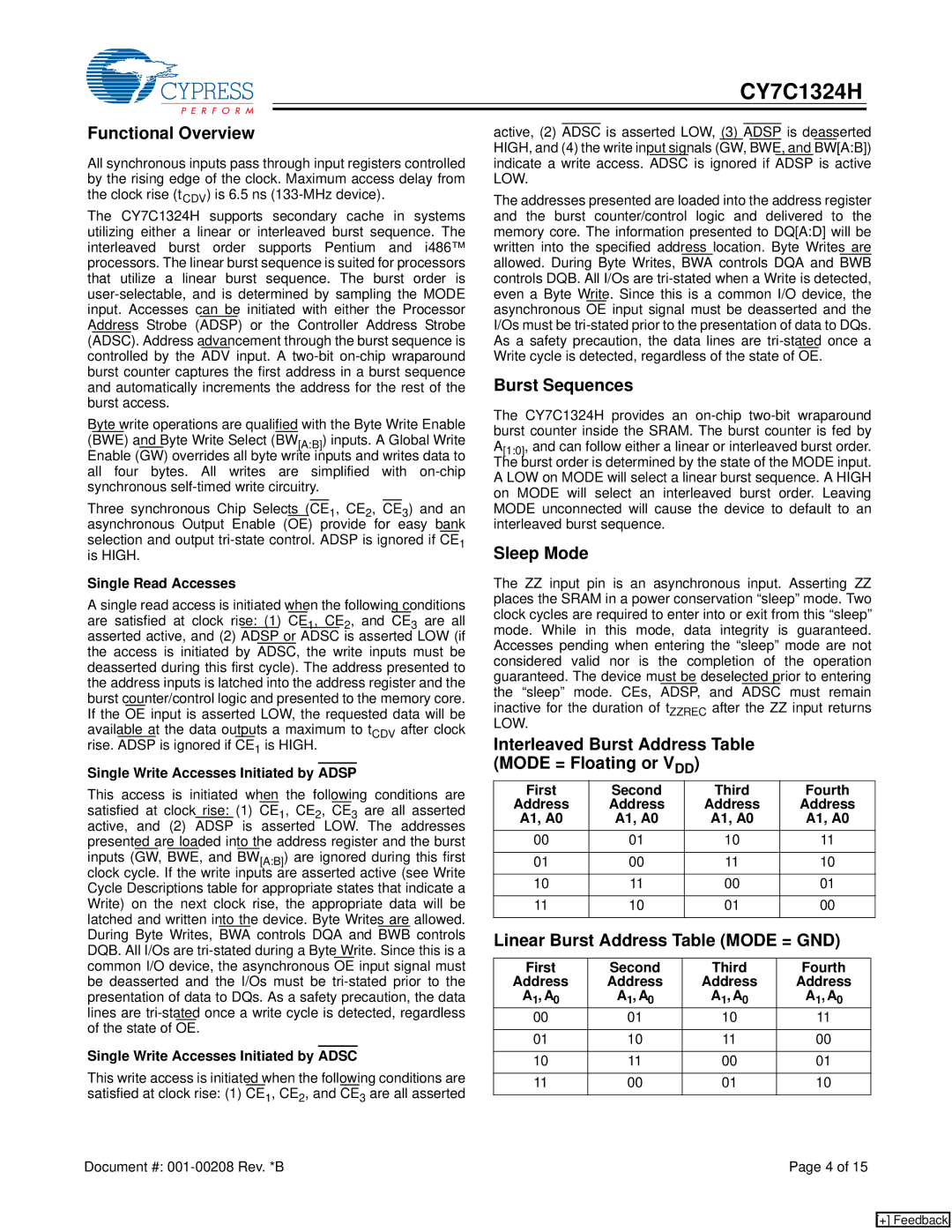Functional Overview
All synchronous inputs pass through input registers controlled by the rising edge of the clock. Maximum access delay from the clock rise (tCDV) is 6.5 ns (133-MHz device).
The CY7C1324H supports secondary cache in systems utilizing either a linear or interleaved burst sequence. The interleaved burst order supports Pentium and i486™ processors. The linear burst sequence is suited for processors that utilize a linear burst sequence. The burst order is user-selectable, and is determined by sampling the MODE input. Accesses can be initiated with either the Processor Address Strobe (ADSP) or the Controller Address Strobe (ADSC). Address advancement through the burst sequence is controlled by the ADV input. A two-bit on-chip wraparound burst counter captures the first address in a burst sequence and automatically increments the address for the rest of the burst access.
Byte write operations are qualified with the Byte Write Enable (BWE) and Byte Write Select (BW[A:B]) inputs. A Global Write Enable (GW) overrides all byte write inputs and writes data to all four bytes. All writes are simplified with on-chip synchronous self-timed write circuitry.
Three synchronous Chip Selects (CE1, CE2, CE3) and an asynchronous Output Enable (OE) provide for easy bank selection and output tri-state control. ADSP is ignored if CE1 is HIGH.
Single Read Accesses
A single read access is initiated when the following conditions are satisfied at clock rise: (1) CE1, CE2, and CE3 are all asserted active, and (2) ADSP or ADSC is asserted LOW (if the access is initiated by ADSC, the write inputs must be deasserted during this first cycle). The address presented to the address inputs is latched into the address register and the burst counter/control logic and presented to the memory core. If the OE input is asserted LOW, the requested data will be available at the data outputs a maximum to tCDV after clock rise. ADSP is ignored if CE1 is HIGH.
Single Write Accesses Initiated by ADSP
This access is initiated when the following conditions are satisfied at clock rise: (1) CE1, CE2, CE3 are all asserted active, and (2) ADSP is asserted LOW. The addresses presented are loaded into the address register and the burst inputs (GW, BWE, and BW[A:B]) are ignored during this first clock cycle. If the write inputs are asserted active (see Write Cycle Descriptions table for appropriate states that indicate a Write) on the next clock rise, the appropriate data will be latched and written into the device. Byte Writes are allowed. During Byte Writes, BWA controls DQA and BWB controls DQB. All I/Os are tri-stated during a Byte Write. Since this is a common I/O device, the asynchronous OE input signal must be deasserted and the I/Os must be tri-stated prior to the presentation of data to DQs. As a safety precaution, the data lines are tri-stated once a write cycle is detected, regardless of the state of OE.
Single Write Accesses Initiated by ADSC
This write access is initiated when the following conditions are satisfied at clock rise: (1) CE1, CE2, and CE3 are all asserted
active, (2) ADSC is asserted LOW, (3) ADSP is deasserted HIGH, and (4) the write input signals (GW, BWE, and BW[A:B]) indicate a write access. ADSC is ignored if ADSP is active LOW.
The addresses presented are loaded into the address register and the burst counter/control logic and delivered to the memory core. The information presented to DQ[A:D] will be written into the specified address location. Byte Writes are allowed. During Byte Writes, BWA controls DQA and BWB controls DQB. All I/Os are tri-stated when a Write is detected, even a Byte Write. Since this is a common I/O device, the asynchronous OE input signal must be deasserted and the I/Os must be tri-stated prior to the presentation of data to DQs. As a safety precaution, the data lines are tri-stated once a Write cycle is detected, regardless of the state of OE.
Burst Sequences
The CY7C1324H provides an on-chip two-bit wraparound burst counter inside the SRAM. The burst counter is fed by A[1:0], and can follow either a linear or interleaved burst order. The burst order is determined by the state of the MODE input. A LOW on MODE will select a linear burst sequence. A HIGH on MODE will select an interleaved burst order. Leaving MODE unconnected will cause the device to default to an interleaved burst sequence.
Sleep Mode
The ZZ input pin is an asynchronous input. Asserting ZZ places the SRAM in a power conservation “sleep” mode. Two clock cycles are required to enter into or exit from this “sleep” mode. While in this mode, data integrity is guaranteed. Accesses pending when entering the “sleep” mode are not considered valid nor is the completion of the operation guaranteed. The device must be deselected prior to entering the “sleep” mode. CEs, ADSP, and ADSC must remain inactive for the duration of tZZREC after the ZZ input returns LOW.
Interleaved Burst Address Table (MODE = Floating or VDD)
First | Second | Third | Fourth |
Address | Address | Address | Address |
A1, A0 | A1, A0 | A1, A0 | A1, A0 |
00 | 01 | 10 | 11 |
| | | |
01 | 00 | 11 | 10 |
| | | |
10 | 11 | 00 | 01 |
| | | |
11 | 10 | 01 | 00 |
| | | |
Linear Burst Address Table (MODE = GND)
First | Second | Third | Fourth |
Address | Address | Address | Address |
A1, A0 | A1, A0 | A1, A0 | A1, A0 |
00 | 01 | 10 | 11 |
| | | |
01 | 10 | 11 | 00 |
| | | |
10 | 11 | 00 | 01 |
| | | |
11 | 00 | 01 | 10 |
| | | |

